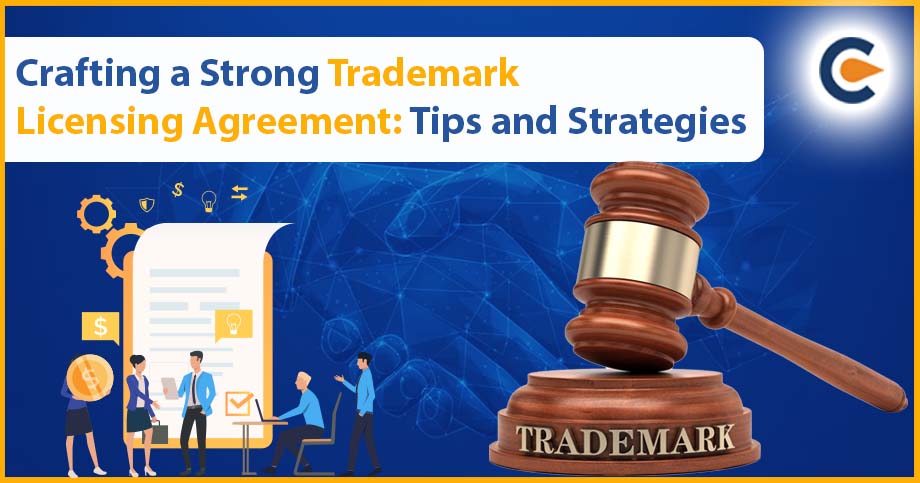One of the most popular ways to monetize an individual’s intellectual property is through trademark licensing. Many companies are deciding to license their unique trademarks to grow their business and increase revenue from their brand names. The licensing agreement is a business arrangement’s most frequent and significant component. A trademark licensing agreement has multiple components. There is no mention of “license” or “licensing” in the Trademark Act 1999[1]. The laws regarding trademark licensing can be found in sections 48-55 of the Trademark Act, 1999.
What A Trademark License Agreement And Why Is It Important?
An agreement granting permission to use a trademark owned by another party on a specific set of terms and conditions is known as a trademark license agreement. A trademark licensing agreement enables a company to increase its market share and profit by leasing its valuable intellectual property to other entities.
This kind of contract is essential for protecting the rights of the trademark holder and maintaining the calibre of the licensed products or services. It lays out specific rules regarding the licensing parameters, the trademark owner’s entitlement to compensation, and how the trademark should be used. A well-written trademark license agreement also ensures that the licensee’s use of the trademark does not damage the reputation or market value of the trademark owner’s brand and helps to prevent future legal problems between the parties.
Important Points and Clauses to Draft a Strong Trademark Licensing Agreement
Following important points & clauses to draft a strong Trademark Licensing Agreement:
- Understanding The Parties
A strong Trademark Licensing Agreement must be drafted with a thorough understanding of all the parties. This entails identifying the trademark owner and the parties wishing to use the trademark. It is crucial to understand the relationship between these parties and the purpose of the license agreement. The trademark(s) belongs to the licensor, who is the trademark owner and has the sole right to use that mark. On the other hand, the parties requesting authorization to use that particular trademark(s) for a particular objective or in a specific market is known as the licensee. This license agreement serves as a legal contract between these two parties (licensor and licensee), which outlines the terms and conditions of the license.
A trademark license agreement might result in legal issues and financial damages if the parties are not understood. To guarantee a solid and effective agreement, it is essential to take time and precisely identify and characterize the parties involved.
- Defining The Scope Of The License
A strong trademark license agreement must clearly define the license’s scope. This entails choosing the precise trademark(s) that will be licensed, the area(s) to which the license is applicable, and the license’s duration. By specifying the trademark(s) being licensed, both the licensor and licensee can be clear on what is permitted use of the trademark(s).
The area(s) to which the license is applicable must be specified. This could be a particular country, area, or perhaps the entire world. It is crucial to make sure that the licensee does not violate any other parties’ rights in such areas when using the trademark(s). The license’s duration must also be specified. This must be expressly stated in the agreement, whether it is for a specific amount of time or indefinitely. If necessary, the licensor can also consider incorporating clauses that allow for early license termination or renewal.
Both the licensor and licensee benefit from the clarity and specificity that the license’s parameters provide. It guarantees that the licensee’s use of the trademark(s) is limited to the terms set forth in the agreement and helps avoid any misconceptions or confusion that might result from ambiguous or unclear language.
- Addressing the Terms of Use
The conditions of usage for the licensed trademark must be covered when drafting a trademark license agreement. The particular conditions of use for the trademark(s) and any restrictions or limitations on their usage should be outlined in this section of the agreement. This makes it easier to make sure the licensee uses the trademark(s) in a way that is consistent with the reputation and brand of the licensor. Any limitations on the use of the trademark(s) in particular markets or industries may also be covered by the agreement.
- Determining Royalties and Fees
A trademark license agreement must consider the royalties and fees clause while drafting it. It is essential to specify the amount of royalties that must be paid to the licensor as well as any other costs or expenses related to the license agreement. Payments given by the licensee to the licensor in exchange for the right to use the license trademark are known as royalties. The amount of royalties can be determined by a flat fee per unit sold or by a percentage of the licensee’s sales revenue. The license agreement needs to make it clear how royalties will be calculated.
The Trademark licensing agreement should also specify the manner and frequency of royalties and fee payments. The deadline for payments and any penalties for late or missed payments should be specified in the agreement. Determining royalties and fees is a crucial aspect of a trademark license agreement, as it establishes the financial obligations of the parties involved. A well-crafted agreement will ensure that both parties understand their financial responsibilities.
- Addressing Termination and Renewal
One of the essential parts of drafting a strong Trademark Licensing Agreement is addressing termination and renewal. The conditions for terminating the licensing agreement and the procedure for renewing it are described in this section. The termination clause should specify the circumstances leading to the agreement’s termination. They include contract violations, insolvency of either party or missed payment deadlines. The clause should also state the notice period necessary before termination can take effect.
A Trademark Licensing Agreement must also take renewal into account. The procedure for renewal, including the notice period and any requirements that must be satisfied before renewal is authorized, should be specified in the agreement. It is crucial to know how long the renewal period will last and whether the initial agreement’s parameters will remain the same or change. The termination clause ensures that either party can terminate the agreement if certain conditions are met, providing a clear exit strategy.
- Considering Dispute Resolution
Contractual violations, non-payment of royalties, and infringement of the license trademark are only a few examples of the many problems that can lead to disputes. The license agreement should have mechanisms for dispute resolution to handle these potential conflicts. The parties can insert a dispute resolution clause specifying how any potential conflicts will be settled. Negotiation, mediation, and arbitration are a few examples of these techniques. The governing law and jurisdiction that will be used in the event of a dispute should also be covered in the license agreement.
- Quality Control
An essential component of any trademark license agreement is quality control. It refers to the procedures and guidelines established to make sure that the goods or services provided under a licensed trademark satisfy the licensor’s standards for consistency and quality.
Establishing precise quality control standards that both parties can adhere to is crucial when creating a trademark license agreement. This may entail detailing the production procedure, supplies, and components employed to create the goods or services supplied under the licensed brand. To ensure the licensee follows the quality control criteria, the agreement may also call for periodic inspections or audits. Quality control procedures also provide the licensor more control over how the trademark is utilized, reducing the chance of unauthorized use.
- Indemnity Clause
The indemnity clause, which covers liability for claims or damages that may result from the use of the licensed trademark, is a crucial element in a Trademark Licensing Agreement. It safeguards the licensor and aids in dividing the risk of any liabilities among the parties. The indemnity clause can also specify the circumstances under which the indemnification obligation applies. To make sure that the indemnification clause is enforceable and that the obligations of both parties are specified, it is crucial to construct it properly. Legal counsel should also examine the clause to make sure it conforms to all applicable rules and laws.
- Confidentiality Clause
A trademark license agreement should include a confidentiality clause to prevent the disclosure of the licensor’s confidential information to unauthorized parties. The licensee’s responsibilities for confidential information, including their duration and any exceptions to them, should be explicitly stated in the provision. The licensee’s sensitive information can likewise be subject to confidentiality obligations on the part of the licensor.
- Grant Clause
An important clause in a Trademark Licensing Agreement is the granting clause. It defines the parameters of the license given to the licensee, needs to be precise and explicit, and includes procedures for quality assurance. This provision must be carefully drafted to safeguard the licensor’s trademark rights and guarantee that the licensed trademark is used lawfully.
Conclusion
In conclusion, it is vital to draft a strong Trademark Licensing Agreement to safeguard the rights of both the licensor and licensee. To accomplish this, it is crucial to take into account several factors, including knowing the parties involved, defining the licensed trademark, determining the license’s scope, putting quality control measures in place, establishing clear financial terms, identifying who owns the intellectual property, and dealing with dispute resolution.
Also Read:
Types Of Trademark: A Complete Overview
Online Trademark Registration: A Detailed Guide
How Can You Apply For Online Trademark Registration In India?











